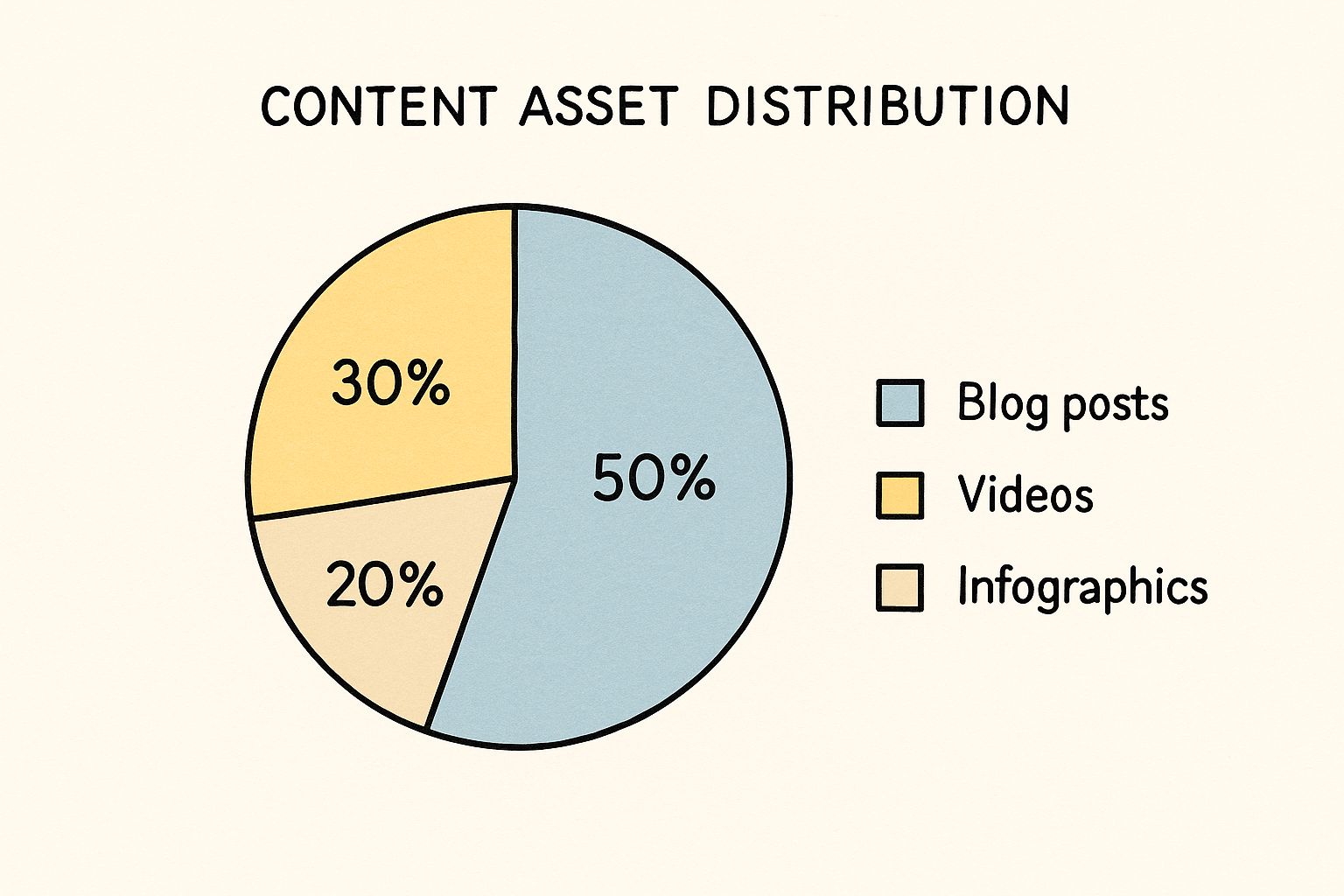A Better Content Marketing Workflow for Authors

A content marketing workflow is really just a repeatable system that takes your ideas from a spark of inspiration all the way through to publication and beyond. Think of it as your roadmap. It sets up clear roles, processes, and tools so you can create great content consistently without burning out.
For an indie author, this is a game-changer. It’s how you stop the frantic, last-minute marketing scramble and start building a sustainable practice that actually grows your audience and sells more books.
Build a Workflow Beyond the Blank Page
Staring at an empty content calendar can feel just as daunting as facing a blank manuscript. I see so many authors fall into the same trap: they post on social media randomly, whenever they feel a burst of inspiration or, more often, a pang of guilt. This kind of reactive marketing leads to inconsistent results, total burnout, and very little to show for it.
A real workflow shifts you from being reactive to proactive. Instead of just hopping on the latest TikTok trend, you’re building an actual system that works toward your long-term goals. Your workflow should be built to achieve things that truly matter for an author's career, like growing an email list of loyal readers, building a powerful author brand, and, of course, driving steady book sales.
Set Clear Goals to Avoid Chaos
First things first, you need to decide what "winning" looks like for you. Is your goal to get 100 new newsletter subscribers every month? Or maybe you want to boost traffic to your book's Amazon page by 20%? Without a clear target, you’re just creating content for the sake of it, and your efforts will feel scattered.
This isn't just an author problem; it's a marketing-wide issue. Even professional marketers struggle when their goals are fuzzy. Some eye-opening research found that among marketers who actually had a documented strategy, only 29% felt it was highly effective. And for those whose strategies were failing? A massive 42% blamed unclear goals. You can dig into more of these content marketing statistics and what they mean for your strategy to see just how critical this is.
A workflow without a goal is just a to-do list. A workflow with a goal is a business asset that systematically builds your author platform and connects you with readers who will buy your next book.
Take a look at this breakdown. It shows how an author might allocate their content efforts, with a strong focus on creating deep, valuable assets like blog posts that can then be repurposed into smaller pieces.

This model is smart because it focuses your energy on creating "cornerstone" content. You write one great blog post, and it becomes the source material for a dozen social media updates, a video script, and a newsletter. It’s all about maximizing your return on effort.
Strategic Versus Reactive Marketing
Having a structured workflow completely changes the game. It turns marketing from a stressful, dreaded chore into one of your most powerful business tools. It brings predictability to your schedule and lets you batch your tasks, which saves an incredible amount of time and mental energy.
To really understand the difference, let’s compare the two approaches.
Comparing Chaotic vs Strategic Marketing Workflows
This table breaks down the difference between the frantic, reactive marketing many authors are stuck in and the calm, proactive system you can build with a workflow.
| Activity | Chaotic Approach (Reactive) | Strategic Workflow (Proactive) |
|---|---|---|
| Idea Generation | "What should I post today?" Scrambling for ideas on the fly. | A backlog of vetted ideas tied to audience interests and book themes. |
| Content Creation | Writing a quick post when you have a spare 15 minutes. | Scheduled blocks of time dedicated to creating high-quality content. |
| Publishing | Posting inconsistently, with long gaps between updates. | Following a planned content calendar for consistent, reliable publishing. |
| Promotion | "Post and pray"—hoping people see it, with no follow-up. | A distribution plan to share content across multiple channels over time. |
| Measurement | Looking at vanity metrics like 'likes' without context. | Tracking key metrics (email sign-ups, clicks, sales) to measure ROI. |
The shift from the "Chaotic" column to the "Strategic" one is absolutely essential for indie authors. You’re already juggling the monumental tasks of writing, editing, and running a business. Consistency, not frantic intensity, is what prevents burnout and leads to real, measurable growth. Your workflow is the engine that makes that consistency happen.
Develop Your Idea Generation System

Let's be honest. Even the most organized content workflow is useless without a steady stream of good ideas. Without them, the whole system just grinds to a halt. The goal here isn’t just to fill a content calendar, but to find topics that genuinely connect with your readers, build your authority as an author, and actually help you sell more books.
What you need is an "idea engine"—a repeatable process you can rely on to source, capture, and vet content topics. For indie authors, this is a game-changer. It gets rid of that "blank page" panic and ensures every piece of content you create has a clear purpose.
Know Your Readers and Where They Gather
The absolute best content ideas come straight from your audience. Your job isn't to guess what they want; it's to become a professional listener.
Start by thinking about your book's core themes and your ideal reader. What problems does your story solve for them? What questions might it spark? Once you have a handle on that, you can start exploring the digital hangouts where your readers congregate. These places are goldmines.
- Goodreads & StoryGraph: Dive into the reviews for books in your niche. What do readers rave about? What frustrates them? Seeing a review complaining about a confusing magic system in a rival's book could spark a blog post like, "5 Hard Magic Systems I Love (And How I Built Mine)."
- Reddit & Facebook Groups: Find the subreddits and groups for your genre (like r/fantasy or a "Cozy Mystery Lovers" group). Lurk in the discussions. What questions pop up constantly? What are the hot debates? These threads give you a direct line into the minds of your future fans.
- Quora & AnswerThePublic: These sites are literally built on questions. Type in your genre or a key trope from your book and see what people are asking. Every single question is a potential blog post, video, or social media thread waiting to happen.
The most powerful content ideas are not invented; they are discovered. They exist as questions, frustrations, and passions within your reader community. Your workflow just needs a system to find and capture them.
Once you start gathering these insights, you'll need a place to organize them. A solid plan is essential. To see how this fits into a larger strategy, take a look at our detailed book marketing plan template, which helps you structure these ideas into a real, actionable plan.
Use Simple Keyword Research
Beyond just listening, you need to know what people are actively typing into Google. Don't worry, you don't need to become an SEO guru overnight. A little keyword research can reveal some incredible topics and help you frame your content to attract readers organically.
Think about it this way: someone might not search for your book by name, but they absolutely will search for "books with strong female leads" or "best sci-fi with found family." These are your keywords.
Fire up a free tool like Google Keyword Planner or Ubersuggest and start exploring terms related to your genre, tropes, and themes. Look for the questions. If you write historical fiction, you might find people are searching for "what did Tudors eat for breakfast?" That's a fun, engaging post that aligns perfectly with your work.
Build Your Idea Capture System
Ideas are slippery. You need a central, reliable place to stash them before they disappear. This system doesn't need to be complex; in fact, simple is usually better. The key is making it so easy to use that you can log an idea the second it pops into your head, whether you're at your desk or waiting for a coffee.
A tool like Trello, Notion, or even a basic spreadsheet works wonders. Here’s a simple way to set it up:
- Create an "Idea Inbox" column. This is your dumping ground. Every new thought goes here, no matter how rough. Just get the core concept down.
- Add columns for your workflow stages. Think "To Research," "Outlining," "Ready to Write," and "Published." This shows your idea's journey at a glance.
- Use labels or tags. This is where the magic happens. Tag each idea with key info like the content pillar (e.g., Writing Craft, Book Promotion), the target reader, or even which book in your series it relates to.
Suddenly, your random notes are transformed into an organized, strategic backlog. When it’s time to plan your content, you won't be staring at a blank slate. You'll have a curated list of vetted ideas, ready to be turned into compelling content your readers will love.
Getting Your Content Made: From Idea to Published Post
Turning a great idea into a polished, published piece of content is often where the whole system breaks down. If you're an indie author, you're already juggling writing your next book, editing, and running the business side of things. The actual production of your marketing content can feel like a black hole that swallows all your time and energy.
The secret isn't about working harder; it's about building a smarter, more efficient system to get it all done. You want to create a predictable rhythm for drafting, editing, and making your visuals. It’s less about reinventing the wheel for every blog post and more about creating a reliable assembly line that churns out high-quality content without burning you out.
The Magic of Batching Your Work
One of the biggest game-changers for my own productivity has been content batching. Instead of writing one blog post from start to finish, I’ll block out time to do just one type of task across several pieces of content. This simple shift helps you build momentum and, most importantly, cuts down on the constant context-switching that absolutely kills productivity.
Here’s what that might look like in the real world:
- Monday morning: I'll spend a couple of hours just outlining my next four blog posts. No writing, just brainstorming and structuring.
- Wednesday afternoon: This is a dedicated three-hour writing block. I'll take two of those fresh outlines and just write the first drafts.
- Friday morning: I’ll pop into Canva for an hour and create all the graphics I need for the week’s content—blog headers, social media posts, you name it.
When you focus on a single activity, you stay in that mental "zone." The work gets done faster, and honestly, the quality is often better because you aren't bouncing from writing to designing to editing all in the same hour.
Keep Your Toolkit Simple
You really don't need a massive, expensive suite of software to create professional-looking content. A handful of well-chosen, easy-to-use tools can handle everything an author needs. My advice? Keep it simple.
Here’s a look at a lean but powerful toolkit:
- For Drafting: You can't go wrong with Google Docs. Its collaboration features are fantastic if you're working with an editor or even just a beta reader.
- For Visuals: For anyone who isn't a graphic designer, Canva is a must-have. You can whip up beautiful blog headers, social media graphics, and even simple videos using their templates.
- For Editing: A tool like Grammarly or ProWritingAid is your first line of defense. It catches typos and awkward grammar before your draft ever gets to a human editor. AI assistants can also be surprisingly good at helping you rephrase a clumsy sentence.
The best tools are the ones you actually open and use. Don't get stuck in analysis paralysis. Pick a few, learn them inside and out, and get to work.
Getting your production system humming isn't just a time-saver; it directly impacts your ability to grow your author business. A smooth workflow lets you tap into one of the most effective marketing channels out there. Time and again, research shows that content marketing generates three times more leads than old-school outbound marketing, and it does so at a 62% lower cost. Fine-tuning your creation process is what gives you consistent access to that power. For a deeper dive, check out these B2B content marketing statistics.
Set Up a Predictable Production Rhythm
Once you have your batching schedule and your tools picked out, the final piece is creating a repeatable, step-by-step flow for every single piece of content. This checklist approach removes the guesswork and makes sure you don't forget a critical step, turning what can be a creative struggle into a clear, manageable process.
Here’s a simple production cadence you can adapt:
- The "Ugly" First Draft: Just write. Get the ideas out of your head and onto the page. Don't worry about it being perfect; that's not the goal here.
- The Self-Edit Pass: Let the draft sit for at least a day. When you come back with fresh eyes, revise for clarity, flow, and structure. Then, run it through your grammar checker.
- Create Your Visuals: Now, make all the graphics you'll need—the main header image, any pictures for inside the post, and the promotional images for social media.
- Final Polish and Formatting: Drop your visuals into the draft, format your headings, add your links, and give it one last proofread to catch any stray errors.
- Load and Schedule: Finally, upload the finished content into your blog or social media scheduler and set it to publish. Done.
This kind of structure is the backbone of a successful content machine. It brings a sense of calm to the creative chaos, freeing you up to focus on what really matters: connecting with your readers and getting back to writing your next book.
Master Content Distribution and Promotion

Hitting “publish” is a great feeling, isn't it? But it’s a milestone, not the finish line. The real magic of a smart content workflow happens after your article or video goes live. Without a solid distribution plan, even the most brilliant blog post is just a digital message in a bottle, hoping someone stumbles upon it.
This is where you build a promotion engine that works for you, ensuring your hard work actually reaches readers. The core idea is brilliantly simple: create once, distribute forever. Instead of constantly grinding to create something new, you’ll learn to see each big piece of content as a goldmine for smaller promotional assets.
Repurpose a Single Idea into a Dozen Assets
The most efficient authors don't necessarily create more content; they get more mileage out of what they already have. This "repurposing" model is the heart of a sustainable workflow. It saves you an incredible amount of time and keeps your author brand visible across different platforms without leading to burnout.
Let’s say you just published a 2,000-word deep-dive into your world-building process. Here’s how you can spin that single asset into a full week’s worth of promotion:
- Twitter Thread: Pull out 5-7 key takeaways and craft them into a compelling thread. Don’t forget to link back to the full article at the end.
- Instagram Carousel: Use a free tool like Canva to design a slick, visual carousel breaking down the main points. Each slide can highlight one core tip.
- Short Video Script: Condense the post into a 60-second script. You can film a quick TikTok or Instagram Reel talking directly to the camera about your top 3 world-building hacks.
- Newsletter Highlight: Don't just dump a link into your newsletter. Write a personal intro explaining why you wrote the post and share an exclusive tidbit that isn't in the original article.
- Quote Graphics: Pull out 3-4 powerful quotes from the post and turn them into simple, shareable images for social media.
This approach transforms one piece of content into multiple touchpoints, meeting your audience on the platforms where they spend their time. This is non-negotiable today. Video, especially short-form, often gets the most engagement, and organic social media is still the main distribution channel for most creators.
In fact, the pressure to produce is so high that 67% of brands now use AI to help streamline their content workflows. You can see more data on these trends shaping content strategy over on AdamConnell.me.
Use Scheduling for a Consistent Presence
As an author, you can’t afford to be chained to social media all day. A truly effective content workflow leans on scheduling tools to maintain an active presence while protecting your precious writing time.
Platforms like Buffer, Later, or Metricool let you load up all your repurposed content and schedule it to post at the best times. You can batch this work, dedicating just an hour or two a week to planning and scheduling all your promotional posts. This frees you up to focus on what really matters: writing your next book.
Your goal with distribution isn't just to broadcast; it's to start a conversation. Scheduling automates the broadcast part so you can focus your energy on genuine engagement when people respond.
This is a vital piece of the puzzle. For a complete look at how this fits into your overall marketing, be sure to check out our comprehensive guide on digital marketing for authors.
Build Community Through Cross-Promotion
Distribution shouldn't be a solo mission. One of the most powerful—and surprisingly overlooked—promotional strategies for indie authors is collaboration. When you build real relationships with other authors in your genre, you create a network effect that can dramatically expand your reach.
Start small. Find authors who write books similar to yours and genuinely engage with their content. Share their blog posts, comment thoughtfully on their social media, and just be a supportive member of the writing community.
Once you’ve built some rapport, you can explore more structured collaborations:
- Guest Posting: Offer to write a guest post for another author's blog on a topic their readers would love.
- Newsletter Swaps: Agree to feature each other's books or lead magnets in your newsletters—a classic win-win.
- Joint Giveaways: Team up with a few authors to run a giveaway where each person contributes a book. This pools your audiences and helps everyone grow their email list.
By weaving these distribution tactics into your workflow, promotion stops feeling like a chore. It becomes a strategic, community-building activity that ensures every piece of content you create works as hard as you do to find new readers and sell more books.
Analyze Performance to Refine Your Workflow
Your content marketing workflow isn't something you create once and then file away. The truly effective ones are living, breathing systems that you constantly tweak and improve. This final piece of the puzzle—analysis and refinement—is what separates a good system from a great one. It’s your feedback loop, telling you exactly what’s working, what’s falling flat, and where to put your most valuable resource: your time.
For an indie author, this doesn't mean you need to get lost in a sea of overwhelming spreadsheets or track dozens of vanity metrics. Not at all. The goal is to focus on a few simple, meaningful data points that directly connect your content efforts to your actual business goals—growing your readership and selling more books.
This cycle of creating, measuring, and adjusting is what turns a simple plan into a powerful engine for growth.
Identify Your Key Performance Indicators
Before you can measure success, you have to define what success actually looks like for you. Forget chasing likes and shares for a moment. Instead, let's focus on metrics that signal genuine reader interest and guide your audience toward buying your books. These are your Key Performance Indicators, or KPIs.
For an author, good KPIs should be tied to tangible outcomes. Here are a few examples of what you could be tracking:
- Email Sign-Ups from a Specific Lead Magnet: That free short story you offered? How many new subscribers did it actually bring in? This directly measures that content's effectiveness.
- Click-Through Rate from Your Newsletter: When you email your list about a new blog post, what percentage of subscribers click the link to read it? This tells you if your subject lines and topics are hitting the mark.
- Website Traffic to Your Book Pages: Are your blog posts successfully nudging interested readers to learn more about your books? Check which posts are the best referrers in your analytics.
- Engagement on Specific Topics: Do you notice that posts about your magic system get double the comments as posts about character development? That's gold. It's valuable data telling you what your readers crave.
The most important metrics aren't always the biggest numbers; they are the numbers that tell you a story about your audience. A single, thoughtful comment on a blog post can be far more valuable than 100 passive 'likes' on a social media update.
This focused approach helps you cut through all the noise. Let's be honest: measuring the direct return on investment (ROI) from content can be tricky. In fact, 56% of marketers report struggling to attribute ROI directly to their content efforts. But what do they rely on most? Website traffic consistently ranks as the top metric for evaluation, guiding how they adjust their content workflow.
Establish a Quarterly Review Process
Tracking data is completely pointless if you never do anything with it. A simple quarterly review is the perfect rhythm for most authors—it allows you to assess your performance without creating a ton of extra work. This is your dedicated time to look at the data, figure out what it’s telling you, and decide how to adjust your workflow for the next three months.
And a quarterly review doesn't need to be an all-day affair. Just block out 90 minutes every three months. That's it.
The Author’s 90-Minute Quarterly Content Review
Here's a simple, repeatable process you can use:
- Gather Your Data (20 minutes): Pull the key metrics you identified earlier. Open up your Google Analytics, your email service provider’s dashboard, and your social media insights. Make a quick list of your best-performing and worst-performing content for the quarter.
- Analyze the "Why" (40 minutes): This is where the magic happens. Look at your winners and losers and ask why they performed that way. Did your top blog post have a killer headline? Did your most-shared social update tap into a viral trend? Was your least-read post on a topic that was just plain boring? Jot down your theories.
- Plan Your Adjustments (30 minutes): Based on your analysis, decide what you're going to change. This is how you actively refine your workflow. Your plan might look something like this:
- Do More Of: "My posts with behind-the-scenes writing tips got really high engagement. I'll create a three-part series on this topic next quarter."
- Do Less Of: "My interviews with other authors received very few clicks. I'm going to pause that format for now and focus on other content types."
This simple process ensures your content strategy evolves and gets smarter over time. You'll build an incredibly deep understanding of what truly resonates with your specific audience. This analytical step is fundamental to any promotional effort. For more ideas on what to do with your best-performing content, you can check out our guide on how to market a book effectively.
This cycle of creation, distribution, and analysis is the secret to building a powerful and sustainable author platform.
Answering Your Content Marketing Workflow Questions

Even with the best-laid plans, building a new system from the ground up is bound to bring up a few questions. It’s completely normal to hit some snags when you're trying to design a content marketing workflow that actually works for you as an indie author. Let's dig into some of the most common sticking points I see and get you some clear, practical answers.
The whole point here isn't to create a rigid, unbending set of rules you feel chained to. It's about building a flexible system that genuinely saves you time and supports your author business, making marketing feel less like a chore and more like a natural part of what you do.
How Much Time Does This Realistically Take?
This is the big one, isn't it? The most honest answer is: it varies. But it's almost certainly more manageable than you're imagining.
For a solo author just getting their sea legs, a good starting point is dedicating around 4-6 hours per week to your entire content marketing effort. That covers everything—from brainstorming ideas and writing a blog post to whipping up some graphics and scheduling it all out.
That might sound like a huge chunk of time, but this is where batching becomes your secret weapon. Instead of scrambling for 30 minutes every single day, you could block off two hours on Monday to write, an hour on Wednesday to create all your social media visuals for the week, and another hour on Friday to schedule everything. It's so much more efficient. The initial setup of your workflow will take a bit longer, but once that machine is running, you'll settle into a sustainable rhythm.
Should I Use a Task-Based or Status-Based Workflow?
This question really just boils down to how much detail you personally need to stay on track. Think of it like following a recipe. Some of us need precise, step-by-step instructions, while others just need a general outline of the ingredients and goal.
Task-Based Workflow: This is your detailed, step-by-step recipe. Each stage has a clear, actionable to-do item: "Write First Draft," "Find Keywords," "Create Graphics." This approach is fantastic if you're new to content marketing or if you plan on handing tasks off to a virtual assistant. There's very little room for confusion.
Status-Based Workflow: This is more of a high-level overview. Stages are defined by where they are in the process, like "In Progress," "Needs Review," or "Ready to Publish." I find that experienced creators who have their personal process dialed in often prefer this because it’s faster to manage and offers more flexibility.
For most authors starting out, I highly recommend a simple task-based system. It helps build good habits and provides much-needed clarity. You can always simplify it later as you gain confidence.
Your workflow is a tool, not a prison. The right system is the one you will actually stick with. Start simple, track what works, and don't be afraid to adjust it to fit your personal style.
What if I'm Not a Designer or Video Editor?
Welcome to the club! Very few authors are also professional graphic designers or video producers. The good news? You absolutely don't have to be. The trick is to keep things simple and lean on the amazing, user-friendly tools now available to everyone.
For graphics, Canva is your best friend. Seriously. You can create beautiful, professional-looking blog headers, quote cards, and social media images in just a few minutes using their templates. When it comes to video, your smartphone is more than powerful enough. In my experience, short, authentic videos of you talking about your writing or a book's theme often perform way better than slick, overproduced content anyway.
Remember, your readers want to connect with you, the author. Authenticity will always trump perfect production value. Just focus on creating content that's valuable or entertaining, and don't let a lack of technical skills hold you back. Your content marketing workflow should be built around your strengths.
Feeling overwhelmed by the sheer number of marketing tasks on your plate? ManuscriptReport.com can help. Our AI-powered reports transform your manuscript into a complete marketing kit in minutes, generating everything from blurbs and ad copy to a full series of blog posts and social media updates. Spend less time on marketing and more time on what matters—your next book. Get your instant book marketing report today!
Related Articles

6 Essential Book Marketing Strategies for Romance Novels
Discover 6 proven strategies to market your romance novel effectively and boost sales.

7 Budget-Friendly Book Marketing Strategies: Complete Guide for Indie Authors
Master budget book marketing with 7 proven strategies that work on $0-$500 budgets. Real ROI data, free tools, and actionable tactics for indie authors.

7 Essential Book Giveaway Strategies to Build Loyalty
Discover 7 essential book giveaway strategies to boost reader loyalty and engagement.